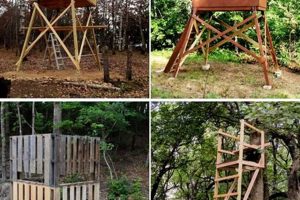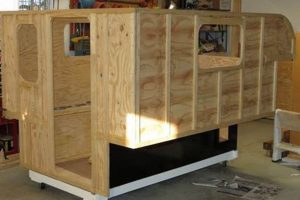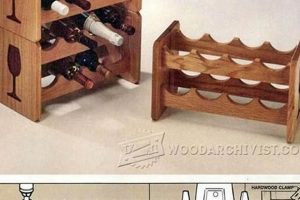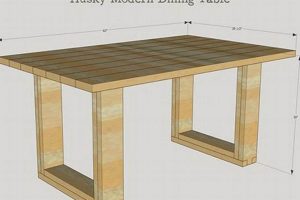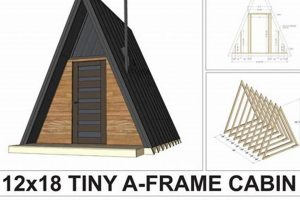Detailed instructions and schematics for constructing loudspeaker enclosures are essential resources for audio enthusiasts and hobbyists. These guides offer step-by-step procedures, dimensional diagrams, and material specifications required to build custom sound systems. For example, a plan might include a cut list for plywood, bracing suggestions, and port calculations optimized for a specific driver.
Constructing personalized audio equipment offers several advantages, including cost savings compared to purchasing commercially manufactured products. Moreover, this approach allows for customization of both aesthetic design and acoustic performance, catering to individual preferences and specific listening environments. Historically, building personalized audio systems has been a cornerstone of the audio hobbyist community, fostering innovation and providing opportunities for experimentation with diverse materials and design principles.
Subsequent discussion will address various enclosure types, driver selection criteria, acoustic modeling techniques, and recommended construction practices relevant to building customized loudspeaker systems.
Guidance for Speaker Enclosure Construction
The following recommendations aim to enhance the design and construction process for custom loudspeaker systems.
Tip 1: Accurate Measurement is Paramount. Ensure precise measurements when cutting materials for the enclosure. Discrepancies can negatively affect the internal volume and baffle dimensions, thereby compromising acoustic performance.
Tip 2: Prioritize Structural Integrity. Use high-quality wood glue and fasteners to create a rigid and airtight enclosure. Weak joints can introduce unwanted resonances and reduce overall sound quality.
Tip 3: Account for Internal Volume Displacement. When calculating the enclosure volume, subtract the volume occupied by the loudspeaker driver, bracing, and any other components inside the cabinet.
Tip 4: Implement Effective Damping. Internal damping material, such as acoustic foam or fiberglass, helps to absorb standing waves within the enclosure, resulting in a cleaner and more accurate sound reproduction.
Tip 5: Crossover Design Requires Precision. The crossover network is critical for proper frequency distribution to each driver. Carefully select crossover components based on driver specifications and desired sonic characteristics.
Tip 6: Proper Sealing is Crucial. Ensure all seams and joints are thoroughly sealed to prevent air leaks, which can diminish bass response and introduce unwanted noise.
Tip 7: Baffle Design Affects Dispersion. The shape and dimensions of the baffle (the front panel of the enclosure) influence the sound dispersion pattern. Consider the intended listening environment when designing the baffle.
Tip 8: Terminal Cup Selection Matters. Choose a high-quality terminal cup with robust connectors for reliable signal transmission.
Adhering to these recommendations will improve the quality and performance of the custom loudspeaker system.
The subsequent sections will delve into specific construction techniques and advanced design considerations.
1. Enclosure Volume
Enclosure volume represents a critical parameter within the context of customized loudspeaker construction. Its relationship to driver performance is causative; the selected volume directly influences the loudspeaker’s low-frequency response characteristics. Insufficient volume can lead to diminished bass output and increased distortion, while excessive volume may result in an uncontrolled, boomy sound. Many plans provide meticulously calculated specifications that show the dimensions based on the parameters.
The accurate calculation and implementation of enclosure volume are indispensable components. Driver manufacturers provide Thiele/Small parameters, which define the electromechanical characteristics of a loudspeaker. These parameters are essential inputs for acoustic modeling software used to determine the optimal enclosure volume for a given driver. For example, a high Qts driver generally performs best in a sealed enclosure with a specific volume to maintain a flat frequency response and control cone excursion. A real-world instance involves a subwoofer designed for a car audio system. Without adhering to the volume specifications derived from Thiele/Small parameters, the subwoofer is unlikely to deliver the desired deep bass extension and may be prone to damage from over-excursion.
A comprehensive understanding of the connection between enclosure volume and driver performance is of practical significance to audio enthusiasts. This understanding enables informed decisions regarding enclosure design and material selection, contributing to the construction of high-quality loudspeaker systems. Challenges may arise in accurately determining the net internal volume, accounting for bracing, and driver displacement. The careful measurements and calculations mitigate these challenges. The volume is a factor in a wide field of variables for a diy speaker. This understanding forms a crucial link in a larger project.
2. Driver Compatibility
Driver compatibility stands as a critical determinant in the successful execution of customized loudspeaker systems. The selection of appropriate drivers, encompassing woofers, tweeters, and midrange units, directly influences overall acoustic performance and necessitates careful consideration of technical specifications and design parameters to achieve optimal integration within a selected plan.
- Thiele/Small Parameters Matching
The Thiele/Small (T/S) parameters of a driver define its electro-mechanical characteristics, including resonant frequency (Fs), compliance (Vas), and total Q factor (Qts). Successful driver selection involves matching these parameters to the intended enclosure design, as specified in many plans. For instance, a driver with a low Qts value is generally better suited for a vented enclosure, while a driver with a high Qts value may be more appropriate for a sealed enclosure. Neglecting T/S parameter matching can lead to suboptimal frequency response, distortion, and even driver damage.
- Frequency Response Alignment
Each driver operates efficiently within a defined frequency range. In multi-way systems, frequency response alignment is essential for seamless integration between drivers. A woofer might cover the low-frequency range, a midrange driver the mid-frequency range, and a tweeter the high-frequency range. Overlaps or gaps in the frequency response can result in uneven sound reproduction and phase cancellation issues. The crossover network must be designed to precisely divide the audio signal and send the appropriate frequencies to each driver.
- Power Handling Considerations
Driver compatibility extends to power handling capabilities. Selecting drivers with sufficient power handling capacity to match the amplifier output is imperative. Overpowering a driver can lead to overheating and damage, while underpowering a driver may result in clipping and distortion. A detailed knowledge of amplifier specifications and driver power ratings is required to ensure reliable and distortion-free operation. This also involves consideration of peak power versus continuous power handling ratings.
- Impedance Matching
Loudspeaker impedance, measured in ohms, is a critical factor for amplifier compatibility. Most amplifiers are designed to operate with specific impedance loads, typically 4 ohms or 8 ohms. Mismatched impedance can result in reduced amplifier efficiency, increased distortion, and potential damage to both the amplifier and the loudspeakers. It is imperative to select drivers with impedance values that align with the amplifier’s capabilities.
The interrelation of Thiele/Small parameters, frequency response alignment, power handling considerations, and impedance matching collectively determines the success of a custom loudspeaker system. Precise adherence to the prescribed plans regarding driver selection ensures acoustic integrity and optimizes overall performance. The failure to account for these facets of driver compatibility can compromise the sonic quality and reliability of the finished loudspeaker system, negating the intended benefits of the custom design.
3. Crossover Network
The crossover network constitutes an integral component within the execution of bespoke loudspeaker projects. Its function is to divide the audio signal into distinct frequency bands, directing each band to the appropriately sized driver (woofer, midrange, tweeter) optimized for its respective frequency range, as prescribed in plans. Consequently, its design and implementation are central to achieving balanced and coherent sound reproduction.
- Frequency Division and Driver Protection
The crossover network divides the full-range audio signal into specific frequency bands tailored to each driver’s capabilities. For example, a high-pass filter directs high frequencies to the tweeter, preventing it from attempting to reproduce lower frequencies that could damage it. Similarly, a low-pass filter directs low frequencies to the woofer. Correctly implemented, the crossover network protects drivers from signals outside their operating range, ensuring longevity and optimal performance. Many advanced diy speaker plans need this approach to fully optimize sound production
- Slope and Order
Crossover networks are characterized by their slope, measured in decibels per octave (dB/octave), which determines the rate at which frequencies are attenuated outside the passband. First-order crossovers have a shallow slope (6 dB/octave), while higher-order crossovers (e.g., 12 dB/octave, 18 dB/octave, 24 dB/octave) provide steeper attenuation. The order of the crossover influences the phase response and the potential for lobing, an off-axis frequency response anomaly. Diy speaker plans often specify the crossover order to achieve the desired sonic characteristics.
- Component Selection and Quality
The components used in the crossover network, including capacitors, inductors, and resistors, directly impact sound quality. High-quality components with low tolerances and minimal signal distortion are essential for accurate frequency division and transparent sound reproduction. Electrolytic capacitors, for example, may introduce distortion compared to film capacitors. Resistors should be non-inductive to avoid phase shifts. Many advanced diy speaker plans rely on high quality components that directly influence quality.
- Impedance Correction and Equalization
Crossover networks can also incorporate impedance correction circuits to flatten the impedance curve of the loudspeaker, presenting a more consistent load to the amplifier. Equalization circuits can be included to compensate for driver deficiencies or to tailor the overall frequency response of the loudspeaker. These techniques are particularly useful in achieving a balanced and linear frequency response in complex loudspeaker designs. This is a good option for those who use custom and/or new types of hardware in their design.
In conclusion, the design and implementation of the crossover network are critical factors in the success of loudspeaker projects. Precise frequency division, appropriate slope selection, high-quality components, and impedance correction contribute to balanced sound reproduction and optimal driver performance. Diy speaker plans emphasizing detailed crossover network specifications tend to yield superior acoustic results. By adhering to recommended practices, builders can realize the full potential of their loudspeaker designs.
4. Acoustic Damping
Acoustic damping is a crucial consideration within the realm of custom loudspeaker construction. Its proper implementation significantly reduces internal resonances and standing waves, thereby improving the clarity and accuracy of sound reproduction, and should be considered when searching for diy speaker plans.
- Standing Wave Mitigation
Standing waves are resonant frequencies that occur within an enclosure due to sound waves reflecting off the internal surfaces. These waves can cause peaks and dips in the frequency response, resulting in coloration and distortion. Damping materials, such as fiberglass or acoustic foam, absorb sound energy, minimizing the amplitude of standing waves. For example, lining the interior walls of a loudspeaker enclosure with damping material reduces the impact of internal reflections, leading to a cleaner and more defined sound output.
- Resonance Reduction
Enclosure panels can vibrate in response to the sound waves produced by the loudspeaker drivers. These panel resonances introduce unwanted coloration and blurring of the sound. Applying damping materials to the interior surfaces of the enclosure reduces panel vibrations, minimizing their contribution to the overall sound. A thicker damping layer can be strategically applied to areas prone to vibration, such as large, unsupported panels. Diy speaker plans should detail the amount of materials and placement.
- Material Selection and Placement
Various materials are used for acoustic damping, each with its specific properties and effectiveness. Fiberglass, mineral wool, acoustic foam, and specialized damping sheets are common choices. The selection of appropriate material depends on the enclosure size, driver characteristics, and desired acoustic outcome. Placement of the damping material is also critical; strategic placement can maximize its effectiveness in absorbing unwanted reflections and resonances. Plans should specify material type and precise location within the enclosure.
- Impact on Bass Response
The degree of damping within an enclosure can influence the bass response of the loudspeaker. Over-damping can reduce bass output and make the sound dull, while under-damping can result in a boomy or uncontrolled bass. Careful consideration of the amount and type of damping material is essential to achieve the desired balance between bass extension and clarity. Diy speaker plans usually recommend a specific amount and placement.
Proper acoustic damping, as specified within a diy speaker plan, is fundamental to achieving high-quality sound reproduction from a customized loudspeaker system. The strategic application of damping materials minimizes internal resonances, reduces panel vibrations, and optimizes bass response, resulting in a cleaner, more accurate, and enjoyable listening experience. The degree of damping depends on the design of the loudspeaker.
5. Baffle design
Baffle design is inextricably linked to the acoustic performance of any loudspeaker, and this relationship is particularly critical within the context of custom loudspeaker projects. The baffle, the front panel of the loudspeaker enclosure where the drivers are mounted, directly influences sound dispersion, frequency response, and overall sonic character. Detailed speaker blueprints provide precise specifications for baffle dimensions, driver placement, and edge treatments. Variations in these parameters exert measurable effects on the sound emanating from the system. For example, a wider baffle tends to increase the loudspeaker’s directivity at lower frequencies, while a narrower baffle offers wider dispersion. Accurate implementation of baffle design elements from these blueprints is thus essential for realizing the intended acoustic properties. Deviations introduce undesirable diffraction effects, such as frequency response irregularities and imaging distortions.
The practical application of correct baffle design is evident in several areas. Proper driver spacing on the baffle minimizes phase interference and comb filtering effects, especially in multi-way speaker systems. Baffle step compensation networks, often incorporated into crossover designs, counteract the change in radiation impedance as frequencies transition from omnidirectional to hemispherical radiation. Chamfering or rounding the baffle edges reduces diffraction, improving image clarity and soundstage width. An illustrative example is seen in high-end loudspeaker designs, where complex baffle shapes are employed to control diffraction and optimize sound dispersion, based on sophisticated acoustic modeling and simulations. Speaker blueprints intended for high fidelity reproduction frequently detail specific edge treatments and driver placements derived from such modeling.
In summary, baffle design represents a significant factor governing the acoustic output of a loudspeaker, and adherence to the baffle specifications within speaker blueprints is crucial. Failure to accurately implement these design elements compromises sound quality, introducing diffraction, uneven frequency response, and distorted imaging. Understanding the interplay between baffle geometry and sound propagation allows builders to leverage loudspeaker blueprints more effectively, resulting in improved acoustic performance. The considerations include challenges such as precise cutting and driver mounting and often require specialized tools. The baffle is also one of the first thing that you see when looking at your loudspeaker, which means that the diy speaker plans need to match the aesthetic goal too.
6. Material Selection
Material selection is a fundamental aspect of realizing successful custom loudspeaker systems from assembly instructions. The physical properties of materials used for enclosure construction significantly affect acoustic performance, structural integrity, and aesthetic appeal. Assembly instructions often provide detailed material recommendations and alternative suggestions, each with corresponding implications for the final product. Choosing a less dense material may result in unwanted vibrations and sound coloration, whereas a denser, more rigid material can reduce these issues but potentially increase the overall cost and weight. For instance, medium-density fiberboard (MDF) is a commonly recommended material due to its consistent density and ease of machining. However, solid hardwood may be preferred for its aesthetic qualities, but it is essential to account for its potentially variable density and susceptibility to environmental factors.
Consider the specific requirements dictated by the enclosure design. Sealed enclosures demand airtight construction to maintain internal pressure, necessitating precise joinery and sealing techniques. Vented enclosures rely on calculated port dimensions, which must be accurately implemented regardless of the chosen material. The selection of damping materials, such as fiberglass or acoustic foam, also directly influences sound absorption characteristics within the enclosure. Assembly instructions might specify the precise type and quantity of damping material required to achieve the desired frequency response. Furthermore, the type of adhesive and fasteners employed directly impacts the structural integrity of the enclosure, ensuring long-term stability and preventing air leaks. Choosing a high-quality adhesive can prevent loosening over time, which can lead to vibrations and rattles.
Ultimately, material selection plays a central role in achieving the intended acoustic and structural characteristics outlined within a given assembly instructions. The optimal choice depends on a range of factors, including budget, aesthetic preferences, and technical expertise. Adherence to the material recommendations, or careful consideration of alternative materials and their corresponding implications, is essential for constructing high-quality loudspeaker systems. The structural design of the diy speaker plans usually details types of materials and volume for the design in order to reduce unwanted resonance.
Frequently Asked Questions
This section addresses common inquiries and misconceptions regarding the utilization of instructions for constructing custom loudspeaker systems.
Question 1: Are blueprints suitable for novice builders?
The suitability of schematics for inexperienced individuals depends on complexity. Simple designs involving basic enclosure construction and pre-built crossover networks may be manageable for beginners. However, advanced plans requiring intricate joinery, complex crossover design, or acoustic modeling necessitate a higher level of skill and experience.
Question 2: What are the essential tools required for constructing loudspeaker enclosures?
Essential tools include a table saw or circular saw for precise cutting of materials, a router for creating rounded edges or recesses, a drill for creating pilot holes and mounting drivers, clamps for securing joints during assembly, and measuring tools for ensuring accurate dimensions. A soldering iron is necessary for assembling crossover networks.
Question 3: How critical is adherence to specified enclosure dimensions?
Adherence to specified enclosure dimensions is critical for achieving the intended acoustic performance. Deviations from the recommended dimensions can significantly alter the frequency response, potentially resulting in diminished bass output, increased distortion, or uneven sound reproduction.
Question 4: Can alternative materials be substituted for those recommended?
Substitution of materials requires careful consideration of their acoustic properties and structural characteristics. Alternative materials should possess comparable density, rigidity, and damping properties to ensure similar performance. Uninformed substitution may compromise the acoustic integrity of the loudspeaker.
Question 5: How is crossover design integrated into loudspeaker constructions?
The crossover network is an essential component that divides the audio signal into frequency bands appropriate for each driver. Instructions typically provide a schematic diagram and a parts list for the crossover network. Accurate assembly of the crossover, using high-quality components, is crucial for proper frequency distribution and seamless driver integration.
Question 6: What are the primary safety precautions to observe during construction?
Safety precautions include wearing appropriate eye and ear protection when operating power tools, using dust masks to avoid inhaling sawdust, and ensuring proper ventilation when working with adhesives or solvents. Exercise caution when handling sharp tools and follow manufacturer’s instructions for all equipment.
Accurate implementation of plans, adherence to safety protocols, and a thorough understanding of acoustic principles are essential for successful execution.
The following section explores resources for obtaining guidance and assistance throughout the construction process.
Conclusion
This exploration has elucidated the essential elements involved in leveraging detailed instructions to construct personalized loudspeaker systems. Key aspects, including enclosure volume, driver compatibility, crossover networks, acoustic damping, baffle design, and material selection, directly influence the resultant audio fidelity. Diligent application of established acoustic principles during the construction process remains paramount.
The pursuit of customized audio solutions through adherence to “diy speaker plans” presents both challenges and opportunities. Success hinges upon a thorough understanding of electro-acoustic principles and meticulous execution. Continued advancements in materials science and acoustic modeling will likely further refine the capabilities of custom-built loudspeaker systems, fostering continued innovation within the audio engineering domain. Those committed to precision and acoustic integrity stand to realize significant benefits from this endeavor.


